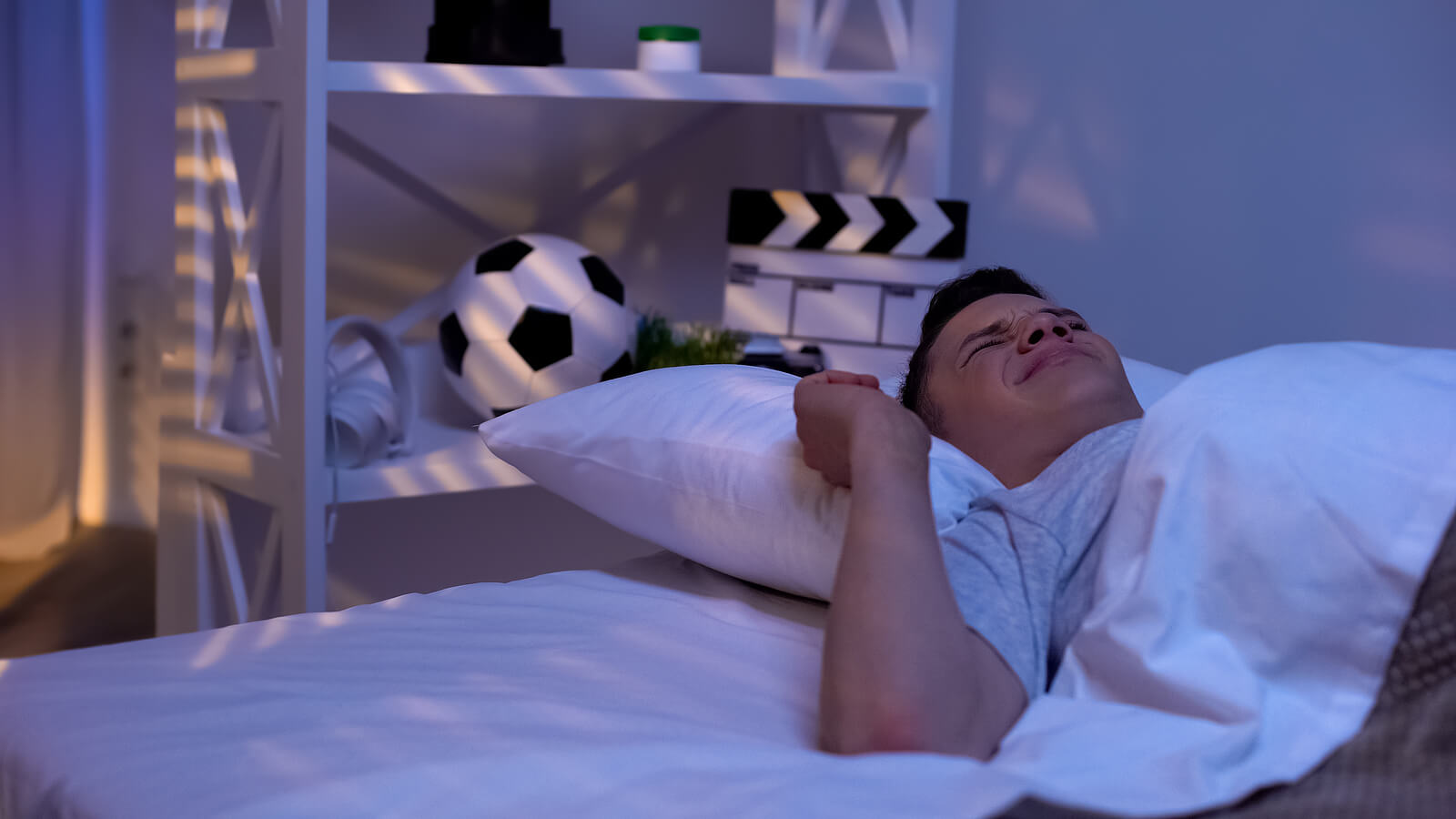Adolescent Sleep Phase Delay Syndrome

Adolescents have a reputation for being lazy, night owls, and sleepyheads. And surely, many parents will affirm that this reputation is more than deserved. However, there are causes that explain this tendency that’s so typical of young people and that we should be aware of before judging or labeling them. For this reason, today we want to talk to you about sleep phase delay syndrome.
This disorder consists of a disturbance of the wake-sleep cycle, which leads the person to go to bed and chronically wake up at least two hours later than usual. Its prevalence in adolescents and young adults is much higher than in the general population, and therefore, it’s quite possible that your child may fall into this category.
Changes in the sleep of adolescents
Before considering the phase delay syndrome, it’s important to know the changes that occur in the sleep of children when they reach adolescence.
Generally, adolescents have the habit of going to bed late, have a hard time getting up at the required time, and are sleepy during school hours. It’s also common for them to sleep late on the weekends.
There are several reasons for this. First of all, there are physiological factors that undoubtedly contribute, as in adolescence the onset of melatonin secretion (natural sleep inducer) is delayed. But there are also psychosocial factors to consider.
In this regard, adolescents may find nighttime to be a time of greater freedom. During these hours, they’re not under parental supervision and can take the opportunity to chat with their friends, use social networks, or carry out activities that are restricted during the day.
At the same time, they manage to feel in control of their own schedules and their own decisions, which somehow gives them that sense of independence and autonomy they seek so much.
Finally, it’s possible that these nighttime hours are the only time available for pleasant activities. During the day, many young people are full of school and extracurricular obligations that leave them no free time. Therefore, they don’t hesitate to steal hours of rest in order to enjoy leisure activities.

Sleep phase delay syndrome
However, despite the above, it’s possible that some adolescents do suffer from sleep phase delay syndrome. As mentioned above, this is characterized by a delay in the need to go to sleep and get up. But before explaining its symptoms, allow us to tell you why it happens.
All human beings follow a circadian rhythm in regard to the wake-sleep pattern, which fluctuates regularly every 24 hours. This alternation is produced by an internal biological clock that’s synchronized with external light-dark cycles. Thus, we become sleepy at dusk and feel more awake and clear during the day.
However, in some people (especially adolescents) this synchronization doesn’t occur, and there’s an imbalance that’s maintained over time. Their internal clock is behind, and for this reason, the release of melatonin occurs between two and four hours later than usual. This is what produces the main symptoms of the syndrome.
Symptoms of phase retardation syndrome
- Problems falling asleep at the socially established sleep schedule. The young person may suffer from insomnia and not be able to fall asleep until several hours after the appropriate time.
- Difficulty getting up early in the morning and feelings of daytime sleepiness. Fatigue and lack of clarity during the first half of the day and a greater activation towards the last hours of clarity.
- Once sleep is achieved, a deep and restful rest is enjoyed and there’s no difficulty in staying asleep.
- If the young person is allowed to go to bed and get up at the time of his or her choice, the difficulties disappear.
- Despite good sleep hygiene and maintaining conventional schedules over a long period of time, adjustment isn’t achieved. In fact, it’s possible that this tendency to delay the sleep cycle was already present in childhood.

Consequences and treatment
If adolescents were free to choose their sleep schedules, many of the consequences of this syndrome would disappear. However, this isn’t possible, as there are school and social obligations to fulfill.
Therefore, being forced to get up early (and not being able to go to sleep early) young people often suffer significant sleep deprivation. This can affect their school performance and daily functioning. Ultimately, they end up looking lazy, sluggish, or disinterested.
Therefore, it’s essential to seek treatment to help alleviate the symptoms. One of the first measures to take is to take care of sleep hygiene: Establish fixed times for going to bed and getting up, avoid using screens at night, and exercise regularly.
Phototherapy (increasing exposure to light as soon as you get up and reducing it before going to bed) usually gives good results. But if it’s also combined with the administration of synthetic melatonin, the effect can be enhanced and the wake-sleep cycle can be advanced until a good adjustment is achieved.
However, it’s always best to consult a physician before taking any of these measures so that the professional can establish the correct diagnosis and determine the best treatment to follow.
Adolescents have a reputation for being lazy, night owls, and sleepyheads. And surely, many parents will affirm that this reputation is more than deserved. However, there are causes that explain this tendency that’s so typical of young people and that we should be aware of before judging or labeling them. For this reason, today we want to talk to you about sleep phase delay syndrome.
This disorder consists of a disturbance of the wake-sleep cycle, which leads the person to go to bed and chronically wake up at least two hours later than usual. Its prevalence in adolescents and young adults is much higher than in the general population, and therefore, it’s quite possible that your child may fall into this category.
Changes in the sleep of adolescents
Before considering the phase delay syndrome, it’s important to know the changes that occur in the sleep of children when they reach adolescence.
Generally, adolescents have the habit of going to bed late, have a hard time getting up at the required time, and are sleepy during school hours. It’s also common for them to sleep late on the weekends.
There are several reasons for this. First of all, there are physiological factors that undoubtedly contribute, as in adolescence the onset of melatonin secretion (natural sleep inducer) is delayed. But there are also psychosocial factors to consider.
In this regard, adolescents may find nighttime to be a time of greater freedom. During these hours, they’re not under parental supervision and can take the opportunity to chat with their friends, use social networks, or carry out activities that are restricted during the day.
At the same time, they manage to feel in control of their own schedules and their own decisions, which somehow gives them that sense of independence and autonomy they seek so much.
Finally, it’s possible that these nighttime hours are the only time available for pleasant activities. During the day, many young people are full of school and extracurricular obligations that leave them no free time. Therefore, they don’t hesitate to steal hours of rest in order to enjoy leisure activities.

Sleep phase delay syndrome
However, despite the above, it’s possible that some adolescents do suffer from sleep phase delay syndrome. As mentioned above, this is characterized by a delay in the need to go to sleep and get up. But before explaining its symptoms, allow us to tell you why it happens.
All human beings follow a circadian rhythm in regard to the wake-sleep pattern, which fluctuates regularly every 24 hours. This alternation is produced by an internal biological clock that’s synchronized with external light-dark cycles. Thus, we become sleepy at dusk and feel more awake and clear during the day.
However, in some people (especially adolescents) this synchronization doesn’t occur, and there’s an imbalance that’s maintained over time. Their internal clock is behind, and for this reason, the release of melatonin occurs between two and four hours later than usual. This is what produces the main symptoms of the syndrome.
Symptoms of phase retardation syndrome
- Problems falling asleep at the socially established sleep schedule. The young person may suffer from insomnia and not be able to fall asleep until several hours after the appropriate time.
- Difficulty getting up early in the morning and feelings of daytime sleepiness. Fatigue and lack of clarity during the first half of the day and a greater activation towards the last hours of clarity.
- Once sleep is achieved, a deep and restful rest is enjoyed and there’s no difficulty in staying asleep.
- If the young person is allowed to go to bed and get up at the time of his or her choice, the difficulties disappear.
- Despite good sleep hygiene and maintaining conventional schedules over a long period of time, adjustment isn’t achieved. In fact, it’s possible that this tendency to delay the sleep cycle was already present in childhood.

Consequences and treatment
If adolescents were free to choose their sleep schedules, many of the consequences of this syndrome would disappear. However, this isn’t possible, as there are school and social obligations to fulfill.
Therefore, being forced to get up early (and not being able to go to sleep early) young people often suffer significant sleep deprivation. This can affect their school performance and daily functioning. Ultimately, they end up looking lazy, sluggish, or disinterested.
Therefore, it’s essential to seek treatment to help alleviate the symptoms. One of the first measures to take is to take care of sleep hygiene: Establish fixed times for going to bed and getting up, avoid using screens at night, and exercise regularly.
Phototherapy (increasing exposure to light as soon as you get up and reducing it before going to bed) usually gives good results. But if it’s also combined with the administration of synthetic melatonin, the effect can be enhanced and the wake-sleep cycle can be advanced until a good adjustment is achieved.
However, it’s always best to consult a physician before taking any of these measures so that the professional can establish the correct diagnosis and determine the best treatment to follow.
All cited sources were thoroughly reviewed by our team to ensure their quality, reliability, currency, and validity. The bibliography of this article was considered reliable and of academic or scientific accuracy.
- Giménez Badia, S., Albares Tendero, J., Canet Sanz, T., Jurado Luque, M., Madrid Pérez, J. A., Merino Andreu, M., & Sellés Galiana, F. (2016). Trastorno de retraso de la fase del sueño y del despertar. Síndrome de retraso de fase. Pediatría Atención Primaria, 18(71), e129-e139. Disponible en: https://www.sciencedirect.com/science/article/abs/pii/S1389945711003431
- Saxvig, I. W., Pallesen, S., Wilhelmsen-Langeland, A., Molde, H., & Bjorvatn, B. (2012). Prevalence and correlates of delayed sleep phase in high school students. Sleep medicine, 13(2), 193-199. Disponible en: https://www.sciencedirect.com/science/article/abs/pii/S1389945711003431
This text is provided for informational purposes only and does not replace consultation with a professional. If in doubt, consult your specialist.








